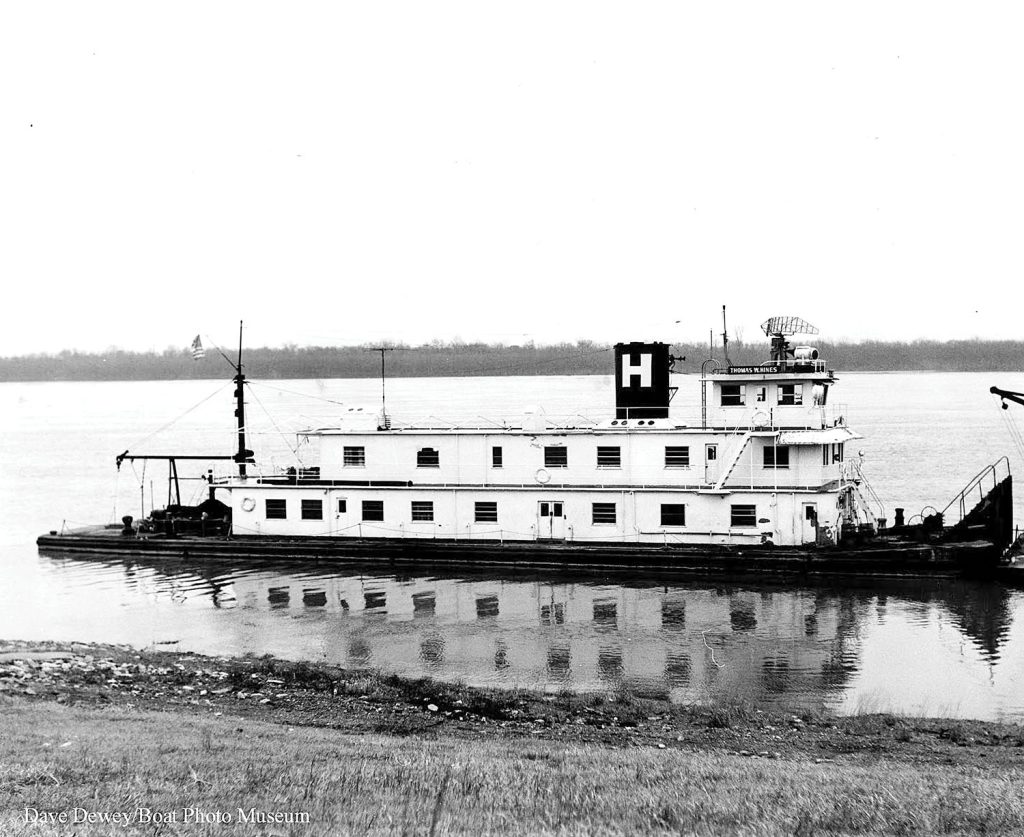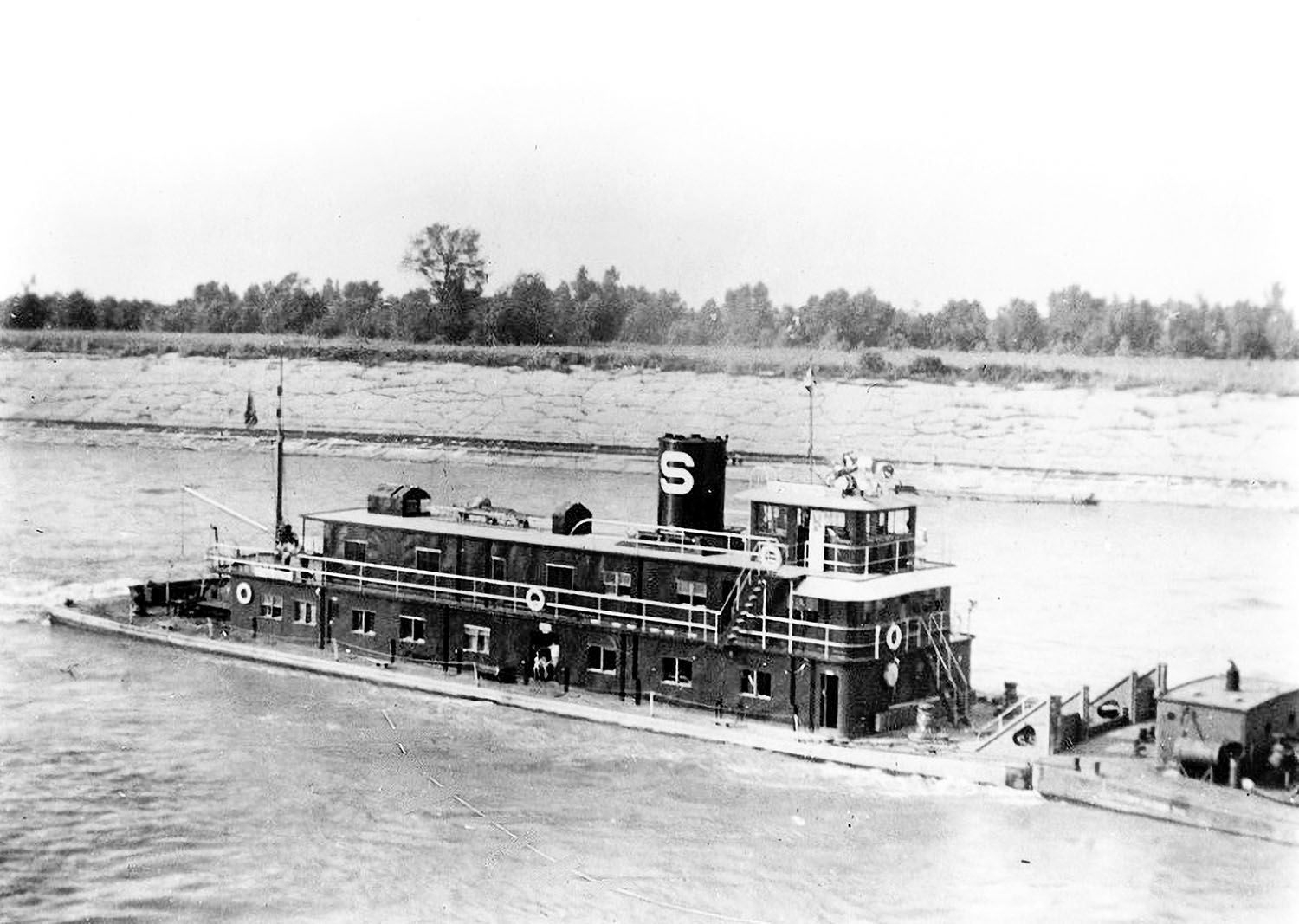It was sad news to read in the January 29 issue of The Waterways Journal that industry leader Capt. Charles Lehman had passed away at age 91. Capt. Lehman was a pleasure to be around and always had witty remarks to make at gatherings such as the Inland Waterways Conferences.
The piece in the WJ announcing his passing mentioned that he got his start on the rivers aboard the St. Paul Socony, and we look at that boat in his honor for this column.
In the September 18, 2023, issue of the WJ, we featured the 1,020 hp. Kansas City Socony, the first towboat in the Socony fleet. It had been built at Kansas City, Kan., in 1937. This was followed by the 1,200 hp. St. Louis Socony, built by the St. Louis Shipbuilding & Steel Company in 1938. In 1940, Socony contracted with the Ingalls Shipbuilding Corporation, Decatur, Ala., for its largest boat so far. Where the Kansas City had been 125 by 32 feet and the St. Louis was 126 by 35 feet, this new boat would be 147 by 35 feet, and it would have some 1,500 hp.
Ingalls Shipbuilding began as Ingalls Iron Works, founded in 1910 by Robert Ingalls in Birmingham, Ala. In 1930, the firm began building barges and small vessels, constructing them in sections that were moved south for completion. In 1936, the yard on the Tennessee River at Decatur was opened. This boat for Socony appears to have been the first towboat that the firm constructed, and it was named St. Paul Socony.
According to Shipbuilding History, the boat came out in October 1940. Photos of it at the time show it dressed in flags with many people on board. As with the other Socony vessels, it was painted red, and it looked very similar to the Kansas City Socony with a long second cabin and a pilothouse above that with a large single smokestack behind it.
The 1,500 hp. driving the boat was provided by a pair of National Superior direct-reversing engines. Photos of the boat were often shown in issues of the WJ in ads for the National Supply Company, distributors of the Superior engines.
Some years later, ads for St. Louis Ship would show this boat on drydock there. The boat is shown from behind, and the photo shows a very long stern extending beyond the slope of the hull. When it came out new in 1940, the boat had a large white “S” on each side of the black stack, but in later years this would be replaced by a shield with the red Pegasus logo.

In 1961, the boat was renamed Mobil St. Paul after Socony became Mobil Oil. In 1968, it was sold, but the ownership trail is somewhat confusing. The 1969 edition of the Inland River Record indicates that it was leased to James R. Hines & Company, Bowling Green, Ky., and renamed Thomas W. Hines. The listing for the boat does not show an actual owner, but in the Owners section the boat is among the vessels owned by Pott Industries Inc., which was the parent company of St. Louis Ship, and shared a common address. The 1971 IRR further confuses the issue by showing the boat under lease to Hines in 1968 but sold to Pott Industries in 1970. Later editions would show it sold to Hines in 1968, and sold to River Equipment Company, which had the same address as Pott Industries, in February 1970.
In checking with Barry Griffith, who is well acquainted with the Hines fleet of that era, he said that it was possible that there was a deal of some sort between Pott and Hines, since a close relationship existed there; however, he had been told at the time that Hines had to take the Mobil St. Paul as part of a contract to move petroleum.
In any case, while operated by Hines, the boat was painted white, and a large white “H” took the place of the Pegasus shields on the sides of the black stack. Griffith also related that the boat was not a favorite among the pilots of Hines, with one saying it handled so poorly that he remarked, “Give me 40 acres, and I’ll turn this thing around.”
In May 1970, the boat was sold to G&C Towing Inc., Point Pleasant, W.Va. In July 1971, it was renamed Sam B, and this writer was always told that this was for the father of Capt. Robert H. Bosworth, the principal owner of G&C. It was a familiar sight on the Upper Ohio and Kanawha rivers while owned by G&C, with the radio call letters WB 5660.
In 1973, the boat was sold to Duty Towing Company, Willow Springs, Mo., and after a fire it once again changed hands, this time going to H&G Marine Service Inc., Perryville, Mo. The boat was rebuilt and repowered with a pair of GM 16V-149 engines of 1,800 hp., returning to service in 1975 as the M.G. Logan. In 1979, it was sold to Godfrey Transportation Company, Godfrey, Ill. In 1980, it was sold to Marseilles Marine & Fleeting, Ottawa, Ill., and renamed Robert J. Carlson.
Also in 1980, the boat was rebuilt at Wood River, Ill., by the Louisiana Dock Company. During this rebuilding, 32 feet of the long stern was removed. The hull was then 115 by 35 feet. During one of the rebuilds the after part of the upper cabin was removed, and the large single stack was replaced by two smaller ones behind the cabin.
The Robert J. Carlson ran on the Illinois and Upper Mississippi rivers until it burned at Marseilles, Ill., in 1984. According to the 1985 edition of the IRR, the hull of the boat was later sold to Egan Marine, Lemont, Ill.
While we have here detailed the first river towboat that Capt. Charles Lehman worked aboard, he had always stated that his personal favorite towboat had been the Trade Winds, built by Hillman Barge & Construction at Brownsville, Pa. in 1949 for American Barge Line, but that is a column for another day.
Caption for top photo: The St. Paul Socony when quite new. (Dan Owen Boat Photo Museum collection)



